今日上海
老西门摄影展展出街区回忆 - 2023年09月19日
Gone but not forgotten: an unconventional 'receptacle of memories'
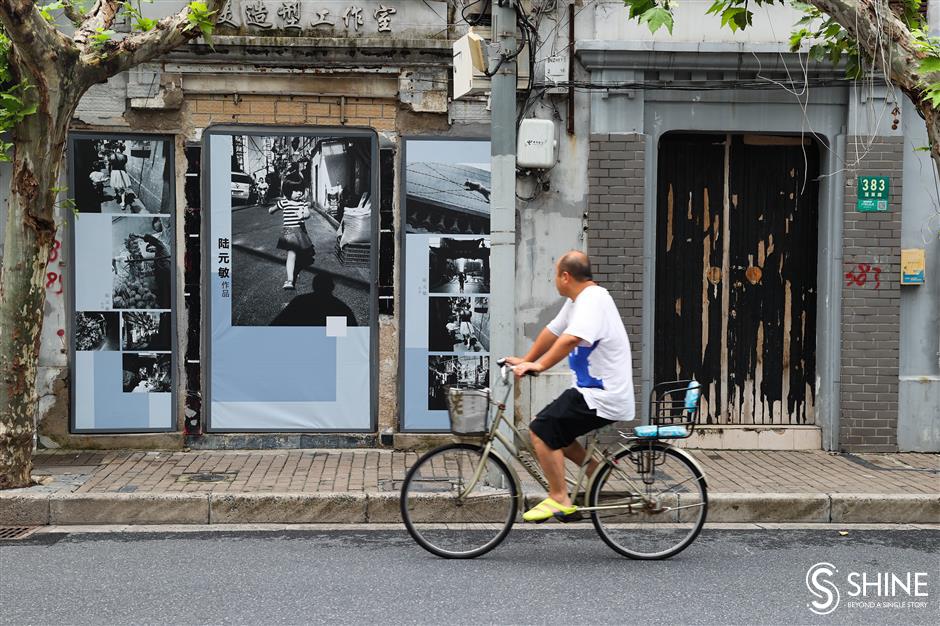
A lane in Laoximen has become a photo gallery of the area's past.
Penglai Road, a lane in Huangpu District where residents have been relocated for urban renewal, is sporting "natural art gallery" of photographs displayed across the facades of old houses.
Some of the 129 pictures have been created by seven Shanghai local photographers; the rest came from participants of a photography contest organized by the subdistrict of Laoximen.
"Photos are receptacles of memories," said Professor Gu Zheng, the Fudan University academic who organized the exhibition. "These photographic works not only revive our memories but also broaden our perception of the city."
Laoximen is often regarded as the cradle of downtown Shanghai. Nicknamed laochengxiang, or literally "old downtown," the area is very close to the City God Temple and Yuyuan Garden. It is home to Wenmiao, the oldest Confucian Temple in Shanghai, and Shanghai Jingye High School, the oldest school in Shanghai, with a history dating back probably to 1748.
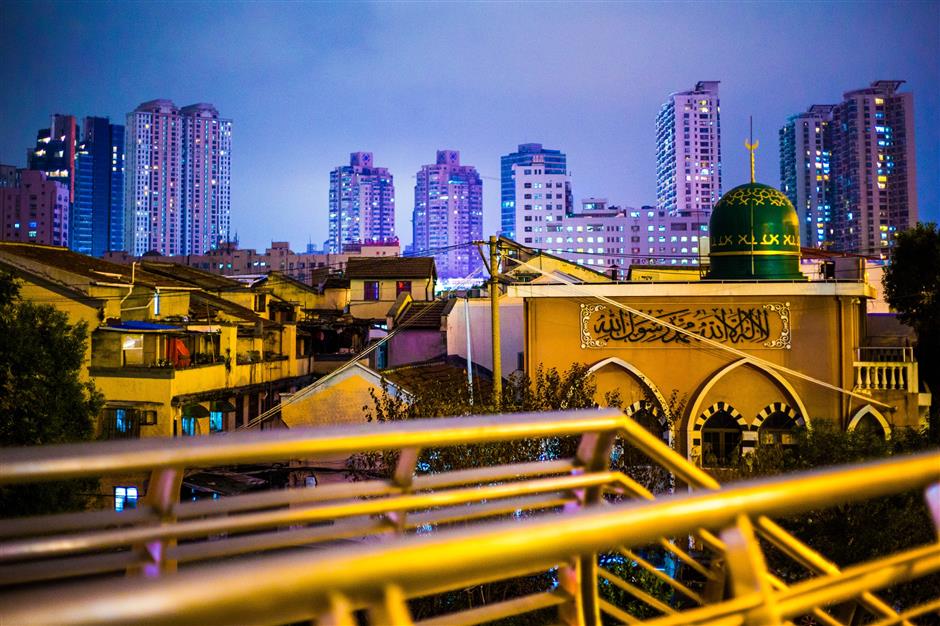
Laoximen before the urban renewal began
In recent years, residents who lived in the century-old lanes in Laoximen were slowly relocated to make room for urban redevelopment. The Confucian temple was closed for restoration in 2021, along with its popular weekend secondhand book market.
"No Shanghai native would not know about Laoximen," said Zhang Li, an exhibit visitor from a nearby neighborhood. "Wenmiao and its surrounding area were the childhood 'holy land' for us who were born in the 1980s. I often bought CDs, stationery and cartoon stickers in small shops, and there were so many snack shops that you can feast for an entire afternoon."
The pictures in the exhibition, however, reminded Zhang more of her old friends than anything else.
"I once had many friends living in the area, but now they have either moved or been relocated," she said. "The city is so big, and lives are so much busier. It's not easy to get together anymore."
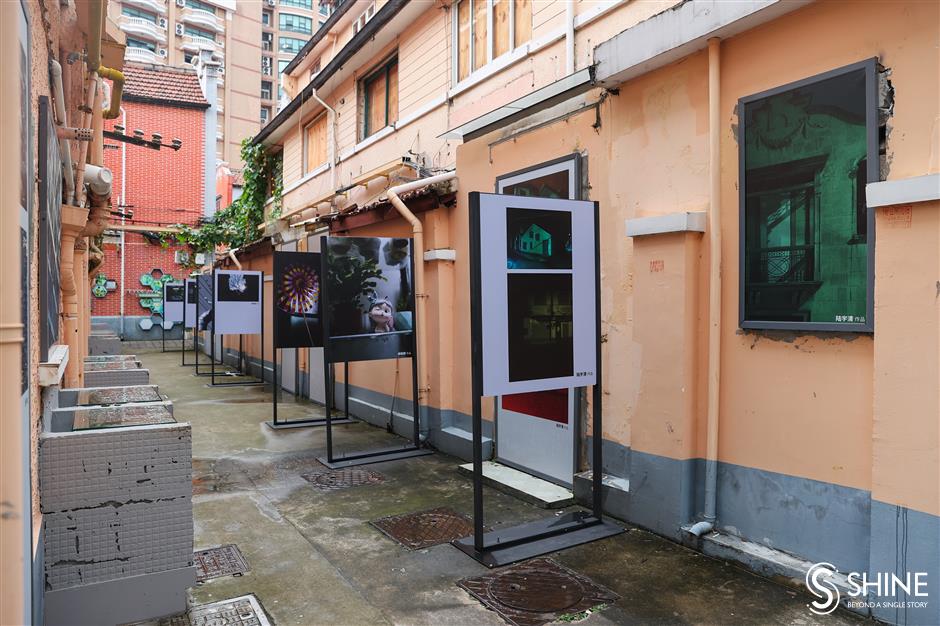
Pictures are spaced along lanes so that visitors have enough space to pose with them.
If the exhibition evokes memories of something or someone, then it hits the right chord.
Xu Haifeng is one of the photographers of the exhibition. His works mainly focus on old items he collected from homes about to be demolished. They include an old Hitachi TV set, a pair of women's sandals and an old videotape.
"Residents are gone, but their breath of life remains in the houses as if they never left" he told Shanghai Daily. "I took the articles back to my studio to photograph, with a projector shining light on them. The lighting has two different meanings. One is that this is the twilight of these articles because their usefulness is over; the other is that maybe they can glow with a brand new life."
Xu, however, said he still felt there was something lacking in the photos and he wanted to give them some complexity.
"I was thinking, 'What was the thing that ties these articles and people?' And I realized it was the relocation itself," he said. "Some people fully embraced a new life and left all their old things behind; others decided to take at least part of their lives with them. The relocation evoked all these emotions."
Xu added to his pictures some of the government slogans encouraging residents to move from their old homes. For a picture of an aluminum pot, he added: "Better City, Better Life; Earlier Expropriation, Earlier Life Improvement." To a glass painting, he added: "Harmonious expropriation benefits both the nation and the people."

The picture of a discarded aluminum pot by photographer Xu Haifeng, collected from a house that was about to be demolished. He later added an expropriation slogan to it.
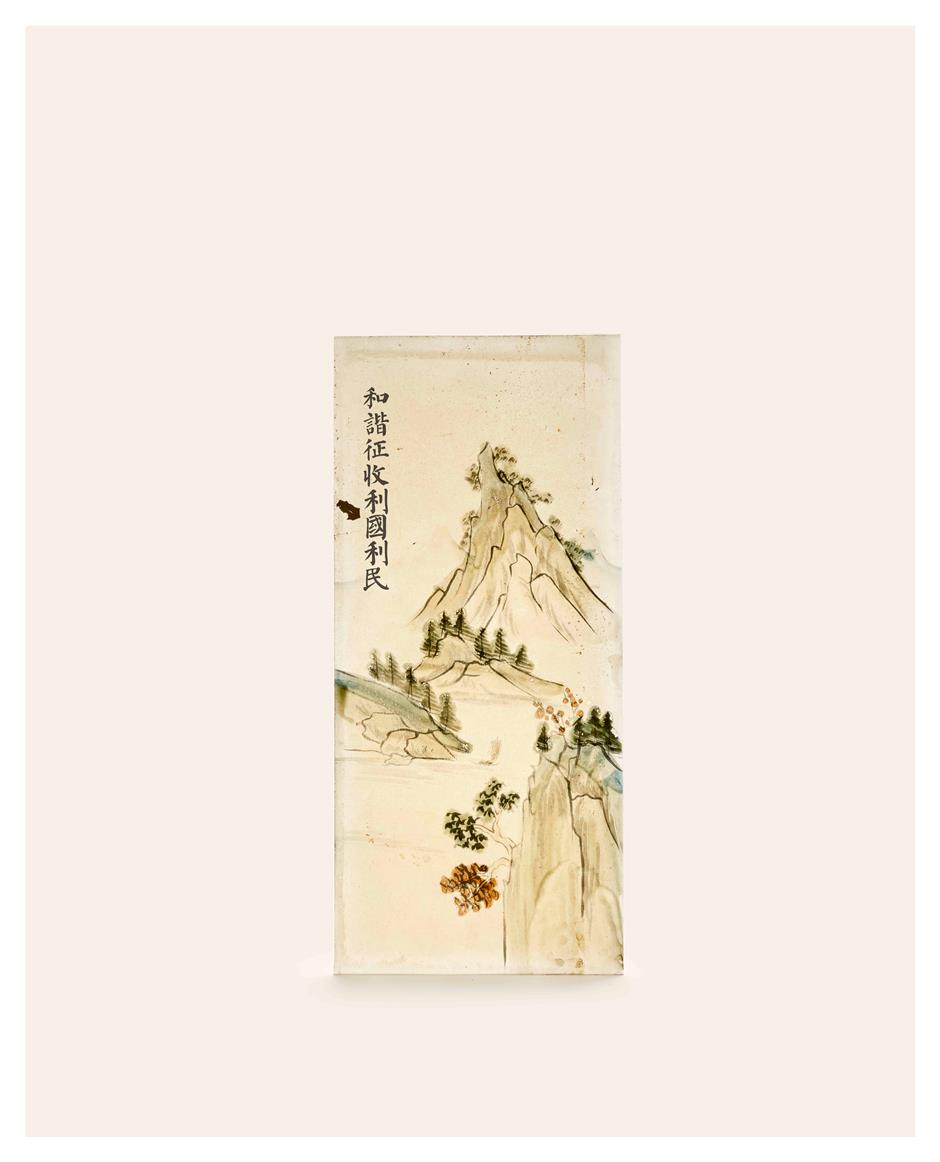
Xu's photo of a glass painting
Another photographer Qu Kailun captures the vitality of an active city life. In his pictures, there is always a sense of motion.
One of his pictures in the exhibition shows a table of food next to two fish tanks. The light is dim, and there is no human in picture, but it still feels alive as colorful goldfish swim around the dishes, seemingly curious about what their owners were eating for dinner.
"All my pictures are taken by chance, and this one was no exception," Qu told Shanghai Daily. "It was before relocation in Laoximen began. One day when I was roaming through the lane, I saw a family that had just finished cooking a meal. They had their door open, and the dishes had just been put on the table next to two fish tanks. I asked them if I could take a picture and they agreed."
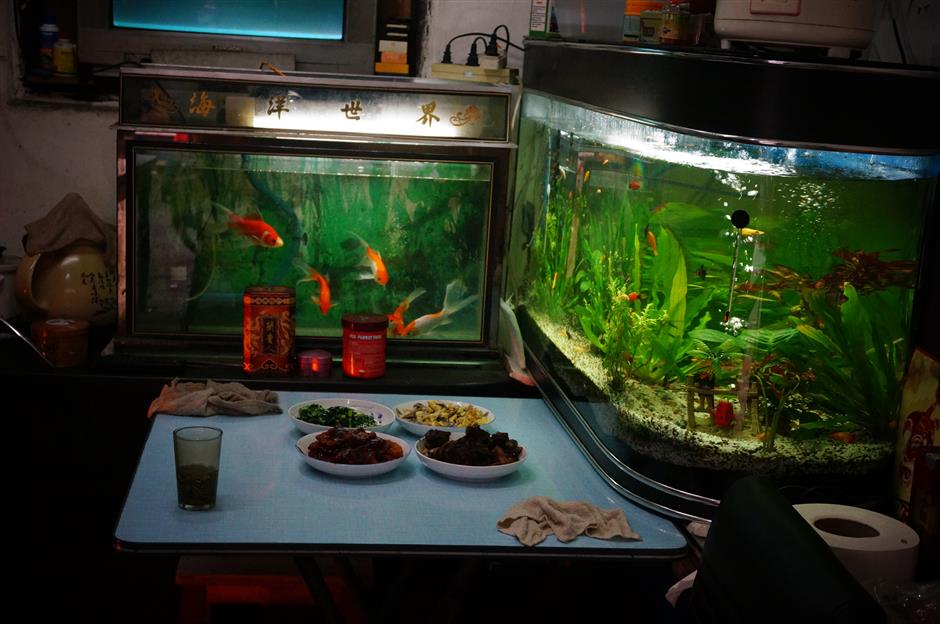
Photographer Qu Kailun captured a dinner table next to two fish tanks from a family that once lived in Laoximen.
Qu said he once lived in an old area of Shanghai for more than six decades and knows what it means to say goodbye to the old and embrace the new.
"It is indeed difficult to leave everything behind, but most residents were eager to embrace better living conditions," he said. "The old houses look good from the outside, but inside many families still had to share kitchens and bathrooms. Living there was even more difficult in bad weather."
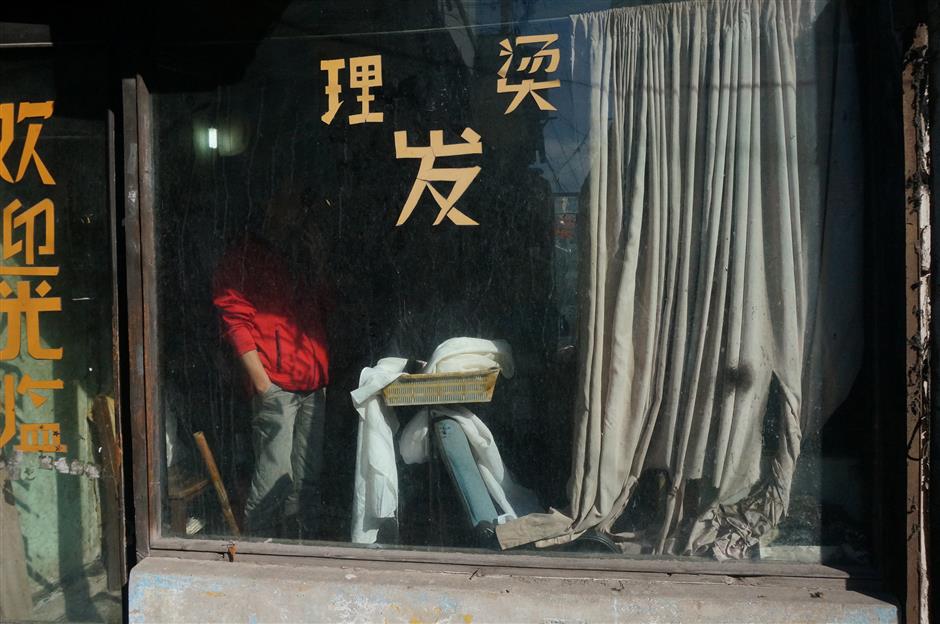
Another photo taken by Qu that features an old barbershop. The faces of the two people inside are hidden in shadow, making viewers wonder what their story might be.
More than 8,000 families have been relocated in Laoximen in the past two years, and many old compounds have been sealed shut.
"The pictures are about the size of a door or window," said Wang Yimin, an official with the subdistrict. "They fuse well with the original buildings, giving visitors an immersive feel."
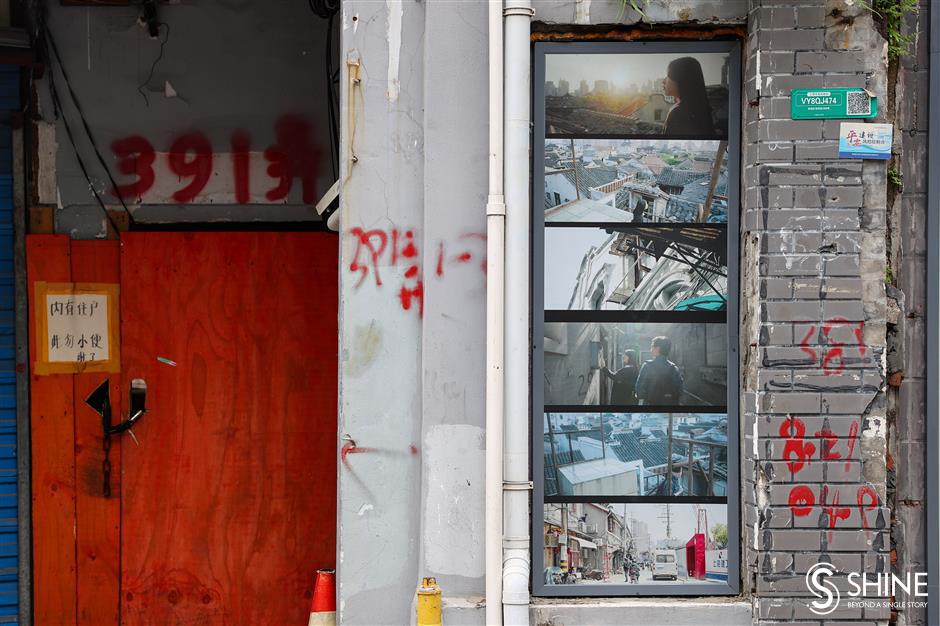
Pictures are spaced along lanes so that visitors have enough space to pose with them.
Wang said the subdistrict will promote more events to showcase the heritage of the area, even after residents have been moved and many buildings torn down.
He cited as one example the Longmencun neighborhood, which dates back to 1935. The lanes resemble an architectural museum of residential buildings, including a Slovakian style rarely seen in Shanghai.
"Laoximen will one day return in a new format, but we will do our best to protect its treasures of the past," Wang said.
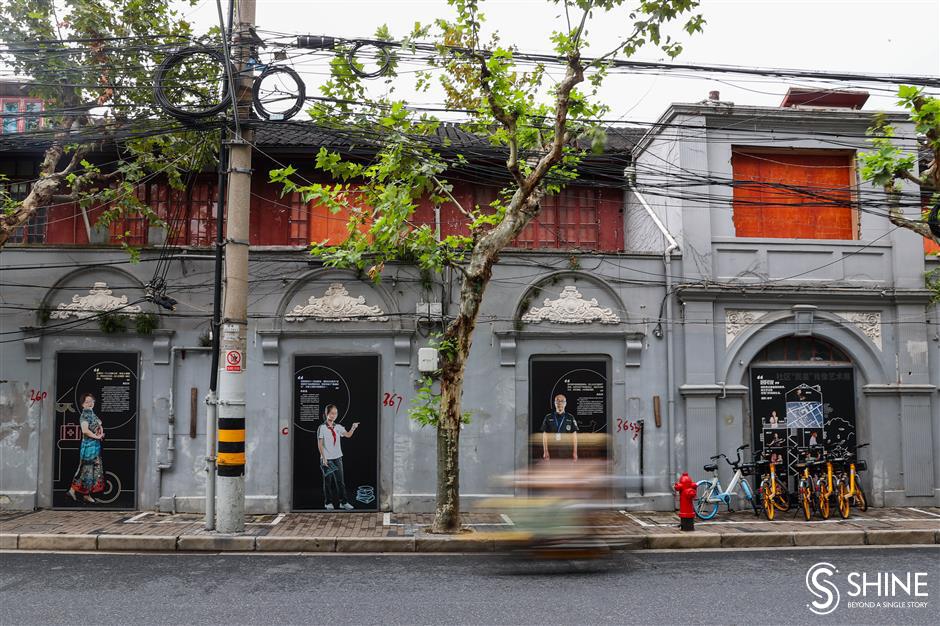
The exhibition displays portraits of Laoximen residents who have been relocated elsewhere.
Laoximen: City Walk Photo Exhibition
Date: through the end of October
Address: 388 Penglai Rd and surrounding streets
Source: Shanghai Daily
